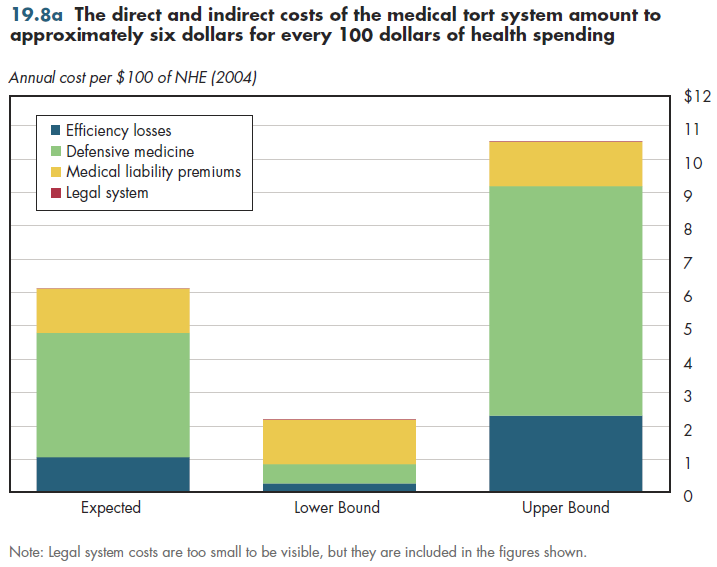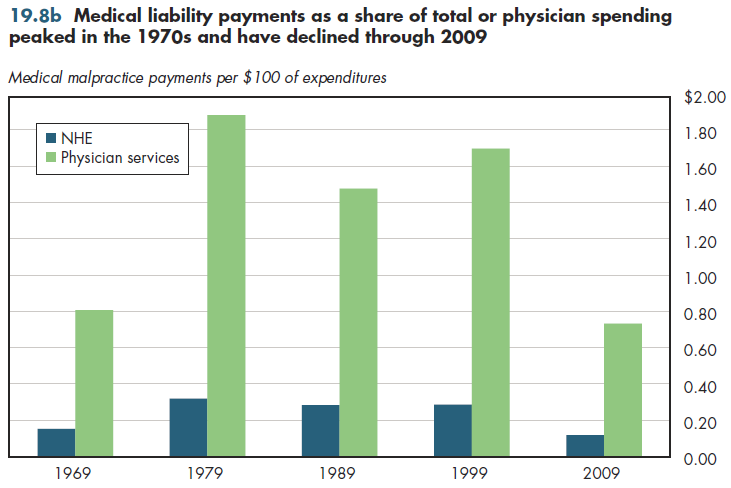Download PowerPoint versions of both figures.
Inside Collection (Book): American Health Economy Illustrated
19.8 Medical Malpractice Explains Some Difference in Health Spending between US and Competitors
Summary: The American system of medical malpractice likely accounts for some, but assuredly not all, of the difference in health expenditures between the United States and its competitors.
The direct and hidden costs of the medical tort system amount to approximately six dollars for every $100 in NHE (figure 19.8a). The visible costs of the legal system and medical liability premiums for health facilities and health professionals equal only approximately 1 percent of health spending.

Defensive medicine, which includes any unnecessary tests or procedures that would be eliminated absent the incentives created by the medical tort system, is almost four times as much as this direct cost. These direct and indirect costs of the medical tort system can be viewed as an excise tax that increases the cost of medical care. If so, then there is another hidden cost in the form of efficiency losses arising from the lost output associated with this medical tort system "tax." There is much uncertainty around these estimates. It is possible that they are as low as two dollars for every $100 in health spending, or as high as $10.
The BEA tracks the annual level of payments for medical liability claims. The United States has experienced a series of medical malpractice "crises" starting in the mid-1970s. Relative to the amount of either total NHE or expenditures only for physician services, these medical liability payments peaked in the 1970s. Currently, these payments represent a lower share of NHE or physician spending than in 1969 (figure 19.8b). This does not suggest that the medical tort system could not be improved, only that it has been relatively worse in the past. Good cross-national estimates of malpractice spending do not exist, but OECD data indicate that the United States has the third-highest rate of deaths from medical errors per 100,000 population.

As a system for compensating victims, the medical tort system has been criticized as both inefficient and unfair. It is inefficient because fewer than 50 cents of every malpractice premium goes to paying victims. It is unfair to both patients and doctors because only a few of those injured due to medical negligence ever seek to recover damages and even fewer win awards. Conversely, many lawsuits filed involve doctors who were not negligent.
Downloads
References
- Conover CJ with EP Zeitler. Health Services Regulation Working Paper No. MTS-1. http://ushealthpolicygateway.files.wordpress.com/2009/06/mts1-medicaltortsys- tem.doc (accessed August 30, 2010).
- Department of Commerce. Bureau of Economic Analysis.
Collection Navigation
- « Previous module in collection 19.7 Americans Pay Higher Prices for Brand-Name Drugs among Major Industrialized Countries
- Collection home: American Health Economy Illustrated
- Next module in collection » 19.9 US Leads the World in Life Expectancy
Content actions
Give feedback:
Download:
Add:
Reuse / Edit:
Twin Cities Campus:
- © 2012 Regents of the University of Minnesota. All rights reserved.
- The University of Minnesota is an equal opportunity educator and employer. Privacy
- Last modified on Sep 24, 2013 3:41 pm -0500









